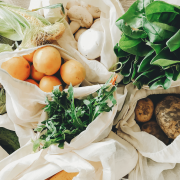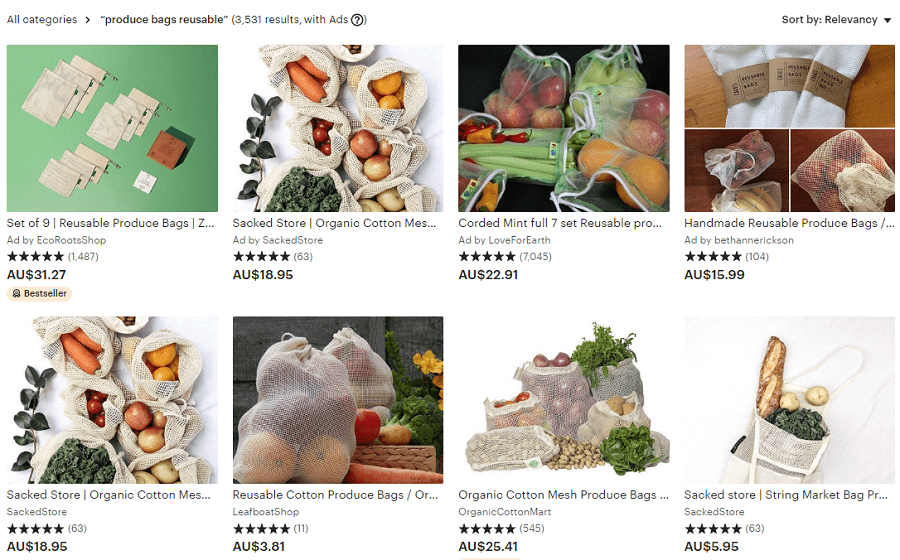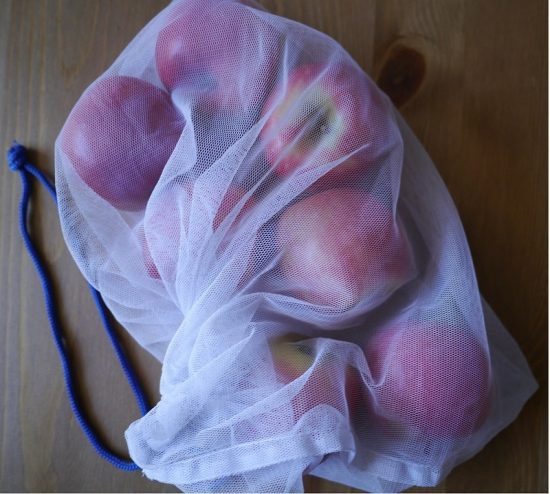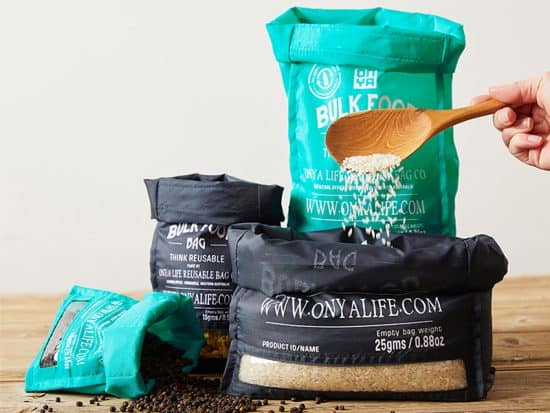A guide to reusable produce bags
When it comes to tackling single-use plastic bags, it isn’t just plastic shopping bags that we want to be replacing with better, reusable alternatives. Plastic produce bags (the extremely thin, colourless, clear bags we see in the fruit and veg aisles at supermarkets) are just as problematic – difficult to recycle, very difficult to reuse and a huge contributor to litter.
Yet the conversation always seems to be around shopping bags, and the produce bags are left out.
Which is a tragedy! There are just as many solutions for replacing single-use produce bags with reusables as there are for shopping bags. Yet it’s something that isn’t on many people’s radar when they are starting out.
It certainly wasn’t on mine.
Fortunately, it is now. I want to share some of the alternatives to single-use plastic produce bags, the pros and cons of different options, as well as a few things you may like to consider.
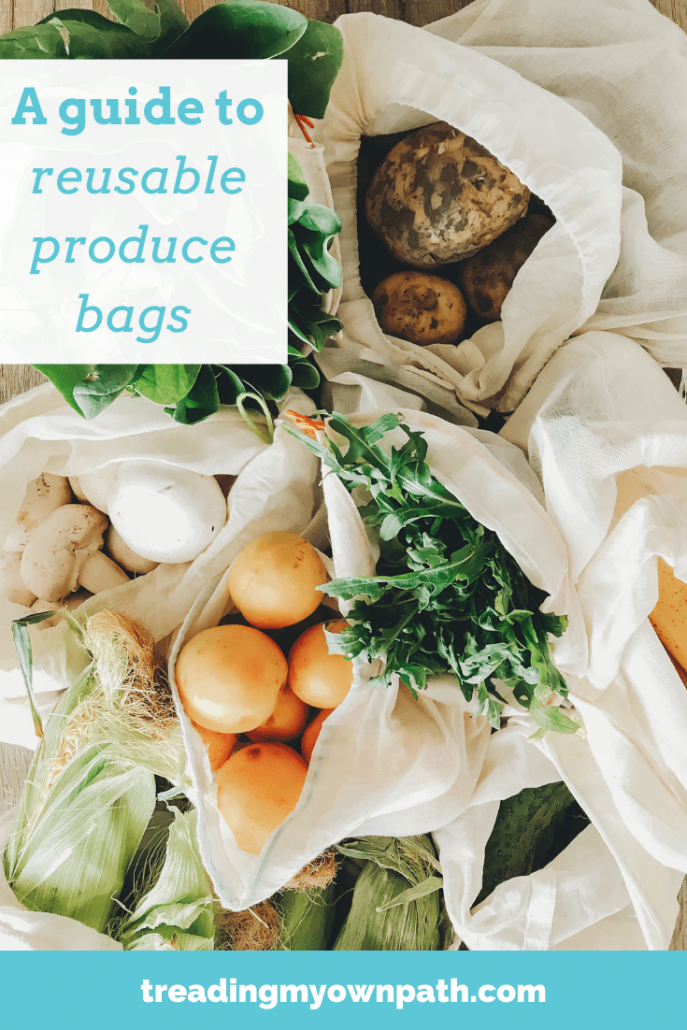
This post contains some affiliate links. You can read more about what this means at the end of the post.
Reusable produce bags – some initial things to consider
There are plenty of options with reusable produce bags. Here’s a few things to consider:
Homemade versus purchased
Homemade is always cheaper, and there’s the option to choose the exact size that you need. If you want bags that last and don’t need to be mended continually, an overlocker generally produces better (longer-lasting) results than a regular sewing machine.
The flipside of homemade is needing access to a sewing machine, and knowing how to sew.
If you do know how to sew, produce bags make great gifts.
Second-hand fabrics
Second-hand fabric is an option for making reusable produce bags, and ready-made produce bags that used second-hand fabric are also available. Fabric includes old net curtains, tablecloths, sheets and old bedding. Choose a fabric that is machine washable and can go through a hot wash (rather than the handwash cycle).
Although mosquito netting seems ideal for produce bags, most mosquito nets are impregnated with pesticides, so not desirable for use with food.
Choosing the fabric type
Different fabrics have different properties. Mesh or net bags are lightweight and see-through, but are rarely made of natural fibres. They’re also not suitable for flour and fine powders.
Cotton cloth is natural but not see-through, and is slightly heavier. (Not all stores have the ability to take off the weight of the bag on the scales, so heavy bags will cost more.) Not being transparent will slow down the checkout operators, so be mindful of using too many of these bags on a busy day.
In practice, it can be useful to have different types for different things.
Reusable produce bags – different options
Personally, I have a combination of homemade and purchased reusable produce bags, and made of different materials.
As much as I recommend making do and using what we have where possible, I also know that sometimes we need shortcuts.
If sewing if definitely not your thing (and you don’t have a relative or friend to persuade to do it for you!) then here are some ready-made solutions.
Mesh fabric produce bags
If you haven’t heard of it or used it before, Etsy is an online marketplace where people who know how to make things sell these things to those of us who do not (or do not have the time). There are plenty of sellers on the platform who make reusable produce bags out of old curtains and tablecloths (as well as sellers who use new fabric, if that’s your preference).
If the second-hand approach appeals to you but you just don’t have the time or inclination, I’d recommend looking on Etsy for reusable produce bags made of upcycled fabric.
There’s no one Etsy seller I recommend, instead I’d suggest browsing and finding the seller that is closest to your home to minimise the packaging and transport footprint.
Recycled PET Plastic Mesh Bags
Some people don’t love the idea of going plastic-free and then buying reusables made of plastic. When I first went plastic-free back in 2012 I was the same. But then I looked into it a little more and adjusted my view.
If we stopped using plastic today, and didn’t make anything else made of plastic, there is still a huge amount of plastic already in existence. Legacy plastic, I call it. From a resource perspective, it makes sense to be using this to make resources rather than leaving it somewhere to sit for all eternity.
PET is the plastic that water bottles is made from. It’s hard wearing and durable. The PET plastic bottles can be recycled into a mesh that is used to make reusable produce bags. These bags have a much lower carbon footprint than other “new” bags because they are made from 100% recycled material.
I have a set of Onya bags that I purchased for my first Plastic Free July back in 2012. They may not be as white as they were when I purchased them, but they function as good as new. (Which cannot be said for my biodegradable ones, which have, well, biodegraded and needed some stitching up).
Mesh bags are great for fruit and vegetables, loose salad leaves (the produce can be washed in the bag) and loose bread rolls.
Cotton Produce Bags
Cotton bags are great for all the things that mesh bags aren’t: powders and flours. I have a set made out of an old bed sheet. The advantage of these is that they can be repaired easily, and composted at the end of their life.
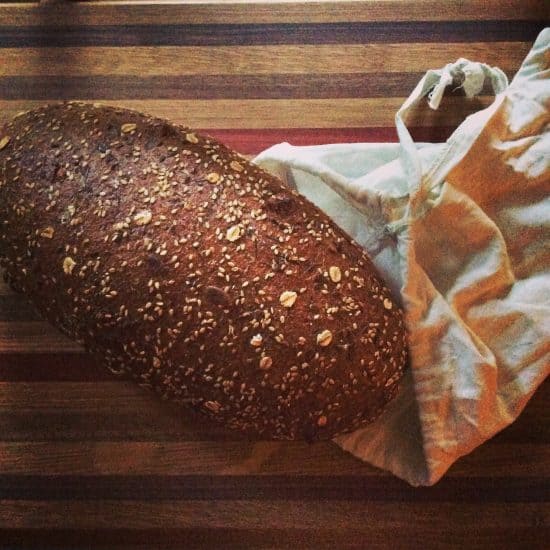
It’s possible to buy new cotton reusable produce bags: I’d recommend looking at your local bulk store as they will often stock them.
I’d always recommend supporting a local brick-and-mortar store where you can, but if this isn’t an option, they can easily be found online.
- Australia or New Zealand – I recommend Biome
- UK: I recommend &Keep
- USA: my first choie would be Life without plastic
If you’re further afield here’s a list of independent online plastic-free and zero waste stores.
Bulk reusable food bags
These reusable produce bags are a fairly new idea, and are designed for bulk store shopping (as opposed to fruit and veg shopping). Whilst reusable produce bags are very easy to transport, they aren’t ideal for storing food.
Onya Life launched these bulk bags in 2019 (made of recycled PET, which I talked about above) as a lightweight alternative to glass jars. They can be labelled and are suitable for food storage.
They are not something I’ve used, but I think they are a great alternative for those of us who don’t want to carry huge amounts of glass jars on our shopping trips, or have to decant everything into said glass jars when we get home.
Other options: making do
Before rushing out and buying anything new, have a think about what you might already have at home. Many bulk stores accept glass jars for refilling, so consider taking jars rather than bags, if that is practical. A pillowcase makes an excellent cotton bread bag. Laundry bags are a mesh alternative to mesh produce bags – and they are definitely machine washable.
If you do decide to buy something, just be sure that it is something that you will use. Reusables that sit in the back of the cupboard are not a good use of resources!
The best reusables are the ones you use often.
Now I’d love to hear from you! What reusable options do you use? Do you have one preference, or do you use a combination? If you sew, do you have fabric types you recommend and any to avoid? Are there any other alternatives or DIY hacks that you can suggest? Please share you thought in the comments below!
[leadpages_leadbox leadbox_id=140b48fc6639c5] [/leadpages_leadbox]
Disclaimer: this post contains some affiliate links which means if you click a link and choose to purchase a product, I may be compensated a small amount at no extra cost to you. I only ever recommend products I have used, companies I trust or those that are regularly recommended to me by you, my readers. Making do and buying second-hand are always my first recommendations.

